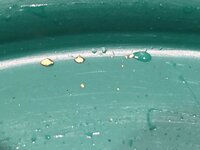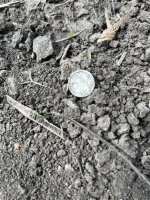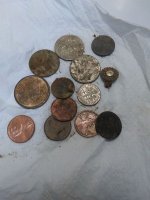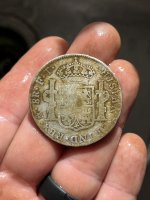matt_unique
Jr. Member
- Jul 16, 2014
- 97
- 63
- Primary Interest:
- All Treasure Hunting
I just completed my 2nd outing with my 2" Keene dredge/highbanker combo using a Honda water pump pushing just under 10,000 GPH.
After my first outing I got rid of my heavy "flexible" hoses that I had used for the clear water suction portion and the clear water discharge portion to the nozzle. These hoses were anything but flexible, heavy, and a pain to carry/store. I replaced these hose sections with the slurry hose I use going from the nozzle to the dredge (Keene's actually flexible rigid hose). During my last outing I punched a hole 3 feet deep over about a day and a half. Over the last few hours at the 3' mark the Keene hose (the clear water discharge portion going from pump to nozzle) started springing leaks every 15 minutes. I did not have a single leak for the first full day, so either it was a wicked coincidence or the 3' depth/pressure change was more than the Keene flexible hose could handle. I tried duct tape but the water was piecing right through that too and shooting 8' in the air. There is a lot of pressure in this section of hose of course because the 2" hose is reduced to 1.25" at the nozzle. So one lesson learned here is I have to revert back to the heavier duty hose for the pump to nozzle portion if punching holes more than about 2' deep.
One question I had was about the system getting plugged with rocks and the resulting water surge when cleared. 99% of them occur in the nozzle of course and a stick clears about 75% of those. The remainder require me to shut off the pump, remove the hose clamp/hose from the nozzle, and clear the plug. Maybe twice over the course of a day a plug occurs where the slurry discharge hose meets the highbanker. My concern is that for all plugs the water flow rate is reduced and then it of course surges when cleared, possibly blowing out any gold in the sluice. How do you guys contend with that? Do you climb out of the hole with every plug to shut off the pump, clear the plug, and then slowly increase the water flow rate?
I have found gold with each outing using my rig. My first outing had nothing but flour size gold (but perhaps 100 pieces). For my most recent outing I had maybe 10 pieces of gold (ouch) but two of them were considerably larger than the flour size I usually get (see pic below) and interestingly all from the first day/shallower depth. I did not find a single spec from my 2nd day (half day at the deeper depth) which is very odd. Size is relative, and I'm still talking about flakes that are picked up with the end of a wet toothpick and dropped into my vial, but still larger than the usual size I get. I use a Gold Cube to process the 1/8" classified sluice concentrates and then I pan the super concentrates. Specific gravity logic would suggest if I am catching flour size gold I would be catching anything larger/heavier, but larger/heavier gold also has more 'windage' so to speak and I wonder if my flow rates/sluice angles are optimized. Based on the suggestion of Buddy I decided to bring home 5G of my sluice discharge to see if I find any gold. I have yet to process that material and it will of course be telling as to whether I have things setup right.
One other question I had is how you guys suggest processing the larger (>1/8") concentrates? Maybe I am fretting over the small stuff when I have nuggets sitting in my buckets at home (ha ha - not likely). I take my 1/8" classified material and classify that through a 3/8". I visually inspect the >3/8" material and then toss in the rock walkway at home. People do find nuggets in Maine though and I want to be sure I am processing the larger material correctly.
I have decided I hate panning. I panned for 20+ years, moved to a sluice, and then this year moved to my current powered rig. I have found gold in the Swift River every single time I have gone since my first outing at 10 when I took a 1-day class through a local college. I would rather dredge for 8 hours than pan for 20 minutes. I used to use a Black Magic miller table for the last few years but in my experience it's not much easier than panning (takes just as long, spend as much time hunched over with a sore back, etc.). Maybe I need a refresher but it takes me forever to pan out a cup of super concentrates. Perhaps I am being too careful/taking too long with the final portions. Anyone share my disdain for panning? Ha ha - if yes - what solutions/products do you use?
Thanks
After my first outing I got rid of my heavy "flexible" hoses that I had used for the clear water suction portion and the clear water discharge portion to the nozzle. These hoses were anything but flexible, heavy, and a pain to carry/store. I replaced these hose sections with the slurry hose I use going from the nozzle to the dredge (Keene's actually flexible rigid hose). During my last outing I punched a hole 3 feet deep over about a day and a half. Over the last few hours at the 3' mark the Keene hose (the clear water discharge portion going from pump to nozzle) started springing leaks every 15 minutes. I did not have a single leak for the first full day, so either it was a wicked coincidence or the 3' depth/pressure change was more than the Keene flexible hose could handle. I tried duct tape but the water was piecing right through that too and shooting 8' in the air. There is a lot of pressure in this section of hose of course because the 2" hose is reduced to 1.25" at the nozzle. So one lesson learned here is I have to revert back to the heavier duty hose for the pump to nozzle portion if punching holes more than about 2' deep.
One question I had was about the system getting plugged with rocks and the resulting water surge when cleared. 99% of them occur in the nozzle of course and a stick clears about 75% of those. The remainder require me to shut off the pump, remove the hose clamp/hose from the nozzle, and clear the plug. Maybe twice over the course of a day a plug occurs where the slurry discharge hose meets the highbanker. My concern is that for all plugs the water flow rate is reduced and then it of course surges when cleared, possibly blowing out any gold in the sluice. How do you guys contend with that? Do you climb out of the hole with every plug to shut off the pump, clear the plug, and then slowly increase the water flow rate?
I have found gold with each outing using my rig. My first outing had nothing but flour size gold (but perhaps 100 pieces). For my most recent outing I had maybe 10 pieces of gold (ouch) but two of them were considerably larger than the flour size I usually get (see pic below) and interestingly all from the first day/shallower depth. I did not find a single spec from my 2nd day (half day at the deeper depth) which is very odd. Size is relative, and I'm still talking about flakes that are picked up with the end of a wet toothpick and dropped into my vial, but still larger than the usual size I get. I use a Gold Cube to process the 1/8" classified sluice concentrates and then I pan the super concentrates. Specific gravity logic would suggest if I am catching flour size gold I would be catching anything larger/heavier, but larger/heavier gold also has more 'windage' so to speak and I wonder if my flow rates/sluice angles are optimized. Based on the suggestion of Buddy I decided to bring home 5G of my sluice discharge to see if I find any gold. I have yet to process that material and it will of course be telling as to whether I have things setup right.
One other question I had is how you guys suggest processing the larger (>1/8") concentrates? Maybe I am fretting over the small stuff when I have nuggets sitting in my buckets at home (ha ha - not likely). I take my 1/8" classified material and classify that through a 3/8". I visually inspect the >3/8" material and then toss in the rock walkway at home. People do find nuggets in Maine though and I want to be sure I am processing the larger material correctly.
I have decided I hate panning. I panned for 20+ years, moved to a sluice, and then this year moved to my current powered rig. I have found gold in the Swift River every single time I have gone since my first outing at 10 when I took a 1-day class through a local college. I would rather dredge for 8 hours than pan for 20 minutes. I used to use a Black Magic miller table for the last few years but in my experience it's not much easier than panning (takes just as long, spend as much time hunched over with a sore back, etc.). Maybe I need a refresher but it takes me forever to pan out a cup of super concentrates. Perhaps I am being too careful/taking too long with the final portions. Anyone share my disdain for panning? Ha ha - if yes - what solutions/products do you use?
Thanks







